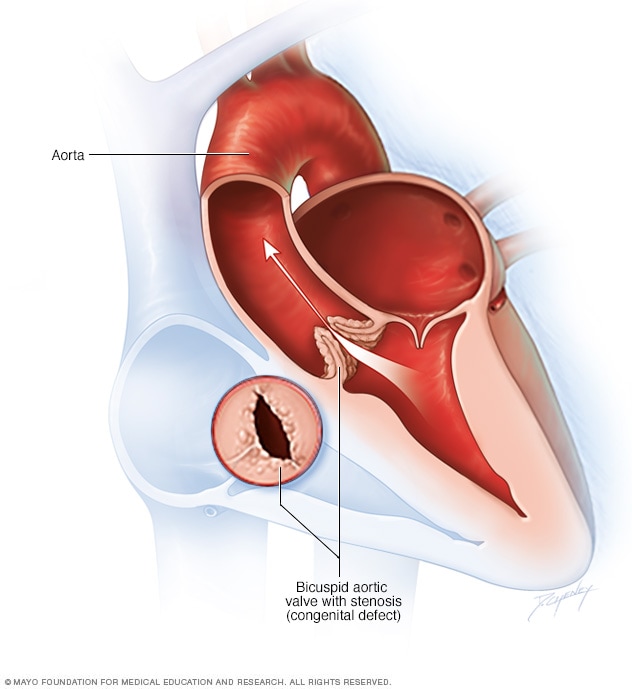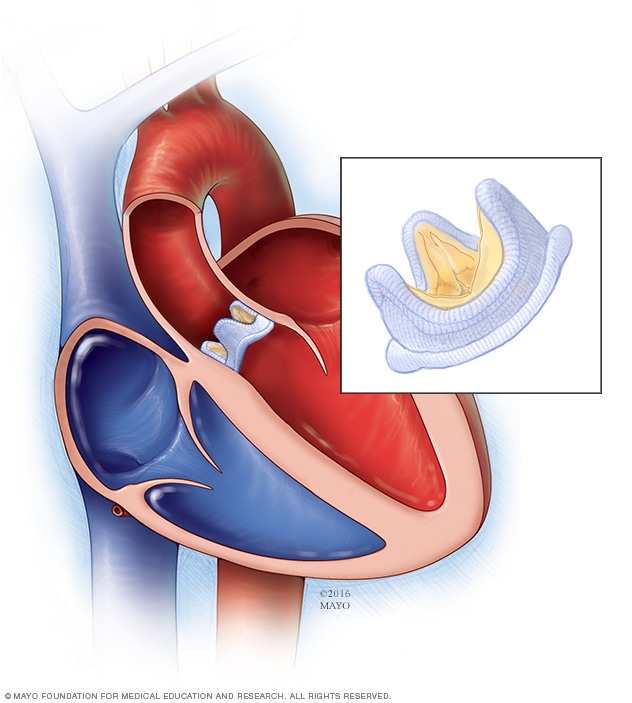Bicuspid aortic valve
Bicuspid aortic valve with stenosis

Bicuspid aortic valve with stenosis
A bicuspid aortic valve has two flaps, called cusps, instead of three. It can cause the valve opening to become narrowed or blocked. When this happens, the condition is called aortic valve stenosis. The heart has to work harder to pump blood into the body's main artery, called the aorta.
Bicuspid aortic valve is a heart condition present at birth. That means it is a congenital heart defect.
The aortic valve is between the left lower heart chamber and the body's main artery, called the aorta. Flaps of tissue on the valve open and close with each heartbeat. The flaps are called cusps. They make sure blood flows in the correct direction.
Usually the aortic valve has three cusps. A bicuspid valve has only two cusps. Rarely, some people are born with an aortic valve that has one cusp or four cusps. A valve with one cusp is called unicuspid. A valve with four cusps is called quadricuspid.
Changes to the aortic valve can cause health conditions, including:
- Narrowing of the aortic valve, called aortic valve stenosis. The valve may not open fully. Blood flow from the heart to the body is reduced or blocked.
- Backward flow of blood, called aortic valve regurgitation. Sometimes, the bicuspid aortic valve doesn't close tightly. This causes blood to flow backward.
- Enlarged aorta, called aortopathy. An enlarged aorta increases the risk of a tear in the lining of the aorta. This tear is called an aortic dissection.
Symptoms
If the bicuspid valve causes severe aortic stenosis or severe aortic regurgitation, symptoms may include:
- Chest pain.
- Shortness of breath.
- Difficulty exercising.
- Fainting or near fainting.
Most people with bicuspid aortic valve don't have symptoms of heart valve disease until they're adults. But some infants may have severe symptoms.
When to see a doctor
If you think that you or your baby has symptoms of a heart condition, make an appointment for a health checkup right away.
Causes
Bicuspid aortic valve happens while the unborn baby, also called a fetus, is growing during pregnancy. Healthcare professionals aren't sure what causes most congenital heart defects, including bicuspid aortic valve. But genetics may play a role in causing bicuspid aortic valve.
Risk factors
A family history of early heart disease may increase the risk of developing heart valve disease such as bicuspid aortic valve. Sometimes bicuspid aortic valve runs in families, which means it is inherited.
Diagnosis
A bicuspid aortic valve may be found when tests are done for another health concern. The healthcare professional may hear a heart murmur when listening to the heart.
An echocardiogram can confirm a diagnosis of bicuspid aortic valve. This test uses sound waves to create videos of the beating heart. It shows how blood moves through the heart chambers, the heart valves and the aorta.
If you have a bicuspid aortic valve, you usually have a CT scan to check for changes in the aorta's size.
Treatment
If you have a bicuspid aortic valve, you are usually sent to a doctor trained in congenital heart disease. This type of doctor is called a congenital cardiologist.
Anyone with a bicuspid aortic valve needs regular health checkups and imaging tests. Echocardiograms can check for a narrowed or leaking aortic valve. The test also looks for changes in the size of the aorta.
Treatment for a bicuspid aortic valve depends on how severe the heart valve disease is. It may include medicines or a procedure or surgery to fix or replace the valve.
Medications
There are no medicines to repair a bicuspid aortic valve. But medicines may be used to treat symptoms caused by heart valve disease. For example, your healthcare professional may recommend blood pressure medicine.
Surgeries or other procedures
Biological valve replacement

Biological valve replacement
In a biological valve replacement, a valve made from cow, pig or human heart tissue replaces the damaged heart valve.
Mechanical valve replacement

Mechanical valve replacement
In a mechanical valve replacement, an artificial heart valve made of strong material replaces the damaged valve.
Surgery may be needed if a bicuspid aortic valve is causing:
- Aortic valve stenosis.
- Aortic valve regurgitation.
- An enlarged aorta.
Surgery is done to repair or replace the aortic valve. The type of surgery done depends on the specific heart valve condition and your symptoms.
-
Aortic valve replacement. The surgeon removes the damaged valve. It's replaced with a mechanical valve or a valve made from cow, pig or human heart tissue. The tissue valve is called a biological tissue valve. Sometimes, the aortic valve is replaced with the person's own lung valve. The lung valve is replaced with a lung tissue valve from a deceased donor. This more complicated surgery is called the Ross procedure.
Biological tissue valves break down over time. They may eventually need to be replaced. If you have a mechanical valve, you need to take blood thinners for life to prevent blood clots. Together, you and your healthcare team can talk about the benefits and risks of each valve type.
- Aortic root and ascending aorta surgery. Surgeons remove the enlarged section of the aorta located near the heart. It's replaced with a synthetic tube, called a graft, which is sewn into place. Sometimes, only the enlarged part of the aorta is removed. The aortic valve remains. The aortic valve also can be replaced or repaired during this surgery.
-
Balloon valvuloplasty. This procedure can treat aortic valve stenosis in infants and children. In adults, the aortic valve tends to narrow again after the procedure. So it's usually only done if you're too ill for surgery or you're waiting for a valve replacement.
This heart valve treatment uses a thin, flexible tube called a catheter. The catheter has a balloon on the tip. The surgeon inserts the catheter into an artery in the arm or groin. Then the catheter is guided to the aortic valve. Once in place, the balloon inflates, making the valve opening bigger. The balloon is deflated. The catheter and balloon are removed.
Lifestyle and home remedies
Anyone born with a bicuspid aortic valve needs health checkups for life. A doctor trained in heart diseases, called a cardiologist, should examine you for changes in your condition.
People with a bicuspid aortic valve are more likely to get an infection of the inner lining of the heart's chambers and valves. This infection is called infective endocarditis. Proper dental care can help lower your risk.
A bicuspid aortic valve can be passed down in families, meaning it's inherited. Parents, children and siblings of someone with a bicuspid aortic valve should have an echocardiogram to check for the condition.
Dec. 07, 2024